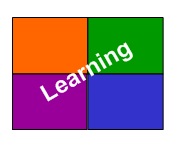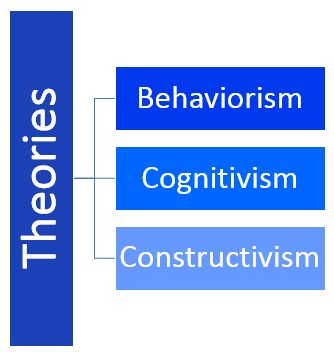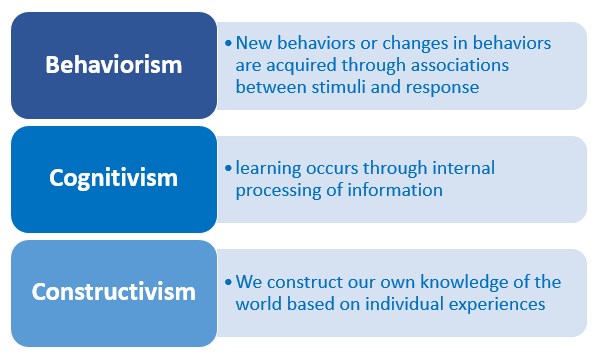Learning Theories
Learning theories are an organized set of principles explaining how individuals acquire, retain, and recall knowledge. By studying and knowing the different learning theories, we can better understand how learning occurs. The principles of the theories can be used as guidelines to help select instructional tools, techniques and strategies that promote learning.
Three learning theories:
- Behaviorism
- Cognitive Information Processing (Cognitivism)
- Constructivism
Behaviorist
New behaviors or changes in behaviors are acquired through associations between stimuli and responses
Cognitive
Information processing leads to understanding and retention
Constructivist
We construct our own knowledge of the world based on individual experiences
Behaviorism
Behaviorism stems from the work of B.F. Skinner and the concept of operant conditioning. Behaviorism theorists believe that knowledge exists independently and outside of people. They view the learner as a blank slate who must be provided the experience. Behaviorists believe that learning actually occurs when new behaviors or changes in behaviors are acquired through associations between stimuli and responses. Thus, association leads to a change in behavior.
Learning process
The learning process is based on objectively observable changes in behavior. Behavior theorists define learning simply as the acquisition of a new behavior or change in behavior. The theory is that learning begins when a cue or stimulus from the environment is presented and the learner reacts to the stimulus with some type of response. Consequences that reinforce the desired behavior are arranged to follow the desired behavior (e.g. study for a test and get a good grade). The new behavioral pattern can be repeated so it becomes automatic. The change in behavior of the learner signifies that learning has occurred. Teachers use Behaviorism when they reward or punish student behaviors.
Examples and applications of behaviorist learning theory:
- Drill / Rote work
- Repetitive practice
- Bonus points (providing an incentive to do more)
- Participation points (providing an incentive to participate)
- Verbal Reinforcement (saying “good job”)
- Establishing Rules
Unfortunately, Behaviorism instruction does not prepare the learner for problem solving or creative thinking. Learners do what they are told and do not take the initiative to change or improve things. The learner is only prepared for recall of basic facts, automatic responses or performing tasks.
Links
Cognitive Information Processing (Cognitivism)
Cognitive information processing is based on the thought process behind the behavior. The theory is based on the idea that humans process the information they receive, rather than merely responding to stimuli (i.e. that think about what is happening). The changes in behavior are observed, but only as an indictor to what is going on in the learner’s head. The learner’s mind is like a mirror from which new knowledge and skills will be reflected.
Cognitive information processing is used when the learner plays an active role in seeking ways to understand and process information that he or she receives and relate it to what is already known and stored within memory. Cognitive learning theories are credited to Jean Piaget.
Learning process
Cognitive learning theorists believe learning occurs through internal processing of information. Unlike behaviorism, cognitive information processing is governed by an internal process rather than by external circumstance. The cognitive approach to learning theory pays more attention to what goes on inside the learner’s head and focuses on mental processes rather than observable behavior. Changes in behavior are observed, and used as indicators as to what is happening inside the learner’s mind.
Learning involves the reorganization of experiences, either by attaining new insights or changing old ones. Thus, learning is a change in knowledge which is stored in memory, and not just a change in behavior.
Examples and applications of cognitive learning theory:
- Classifying or chunking information
- Linking Concepts (associate new content with something known)
- Providing Structure (organizing your lecture in efficient and meaningful ways)
- Real world examples
- Discussions
- Problem solving
- Analogies
- Imagery / providing pictures
- Mnemonics
Constructivism
Constructivism is based on the premise that we all construct our own perspective of the world, based on individual experiences and internal knowledge. Learning is based on how the individual interprets and creates the meaning of his or her experiences. Knowledge is constructed by the learner and since everyone has a different set of experiences and perceptions, learning is unique and different for each person.
Learning Process
Constructivist theorists believe that learning is a process where individuals construct new ideas or concepts based on prior knowledge and/or experience. Each of us generates our own mental models, which we use to make sense of our experiences. We resolve conflicts between ideas and reflect on theoretical explanations. Learning, therefore, is simply the process of adjusting our mental models to accommodate our new experiences.
This theory is used to focus on preparing people to problem solve. Therefore, to be successful, the learner needs a significant base of knowledge upon which to interpret and create ideas. Additionally, with Constructivism, outcomes are not always predictable because learners are constructing their own knowledge. Thus Constructivism does not work when the results always need to be consistent.
Examples and applications constructivism:
- Case studies
- Research Projects
- Problem based learning
- Brainstorming
- Collaborative learning / group work
- Discovery learning
- Simulations
Summary
All three theories are important to understand. When deciding which strategies to use, it is important to consider:
- the level of knowledge of the learners
- the thought processing demands, and
- the desired outcome (generation of new ideas or a single answer)
Author: James Kelly, September 2012



